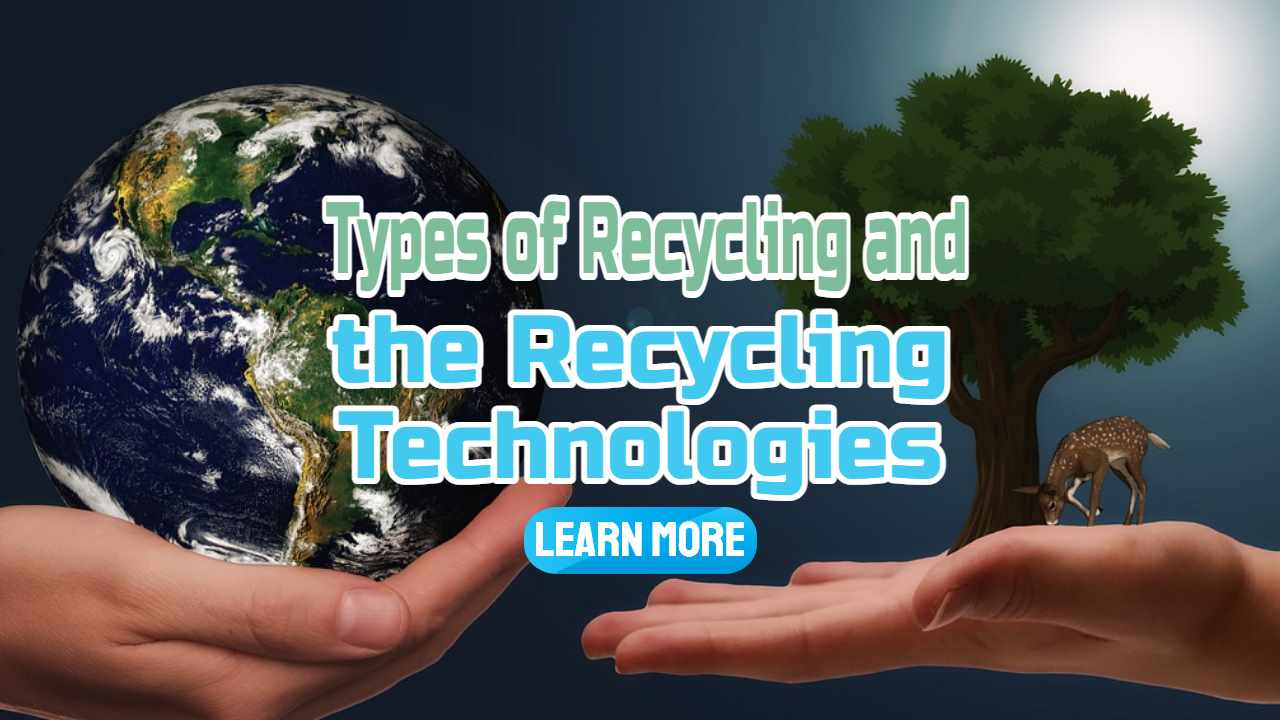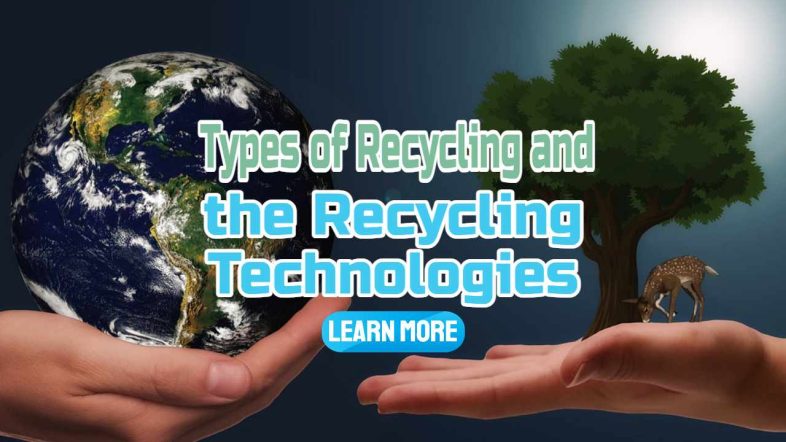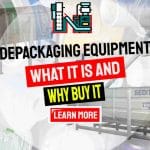When people write articles about the types of recycling they copy other articles and the result is that there is a lot of misinformation on the internet about recycling and recycling technologies. This is not helped by the fact that ideas about how recycling works best are evolving and the definition of recycling has become just one part of the waste management hierarchy.
The term “recycling” is not a generic term for all forms of waste treatment. It has a very specific use, and that is defined by the Waste Hierarchy. Many nations now have a waste hierarchy, but by way of explanation of the types of recycling today we have used the EU's official zero waste hierarchy.
The Zero Waste hierarchy has 7 levels, two related to products and 5 related to waste:
1. REFUSE, RETHINK, REDESIGN
The 1st level encapsulates any activity related to stopping waste from being produced for these types of recycling. Be it by creating a system that is waste-free by design or by stopping the commercialisation of single-use items that can be easily replaced with alternatives.
Examples: of these Types of Recycling
Food delivery, take away food but could be also applied to e-commerce, should use reusable packaging in closed-loop systems. We can see examples in Repack, ReCircle, and Freiburg Cup. For this to become the new norm we need progressive regulations.
2. REDUCE AND REUSE
Staying in the non-waste zone, the second level of the hierarchy tackles the scaling up of the market for used items that have not become waste, remain an underutilised asset of our economies or will become waste despite not having lost their use-value. The goal is to prevent them from being discarded and instead find ways for them to go back into the economy.
Examples:
In the food sector, for these types of Recycling Phoenix has developed a system for supermarkets to prevent food from becoming waste and make it available for consumption.
Ereuse has developed a system to not only stop e-waste from being generated and have the products and components expand their useful life, but also introduce block-chain technology to trace the components for the future, measure their performance and ensure they will be appropriately recycled at the end of their life.
3. PREPARATION FOR REUSE
Moving into the waste area, the third level of the Zero Waste hierarchy reflects the second level of the EU waste hierarchy: preparation for reuse reproduces the efforts to clean, repair and refurbish items that have become waste in order for them to become products again.
Types of Recycling – An Example:
The refurbishment of white appliances such as fridges to make them suitable to be used again.
4. RECYCLING, COMPOSTING, ANAEROBIC DIGESTION
The 4th level of the hierarchy deals with what, in an ideal scenario, should be the last option to retain materials in sustainable resource management, namely to turn the separately collected waste into high quality secondary raw materials. This level mirrors the 3rd level of the previous EU waste hierarchy.
Types of Recycling – An Example:
Turning separately collected paper or cardboard into cellulose for new products or packaging. Turning source-separated high-quality organics into soil improvers by means of composting and/or anaerobic digestion (3) so as to restore the fertility of soils.
5. Types of Recycling MATERIAL AND CHEMICAL RECOVERY
As explained, the Zero Waste hierarchy differs from and supplements the EU’s one in the configuration of its lowest levels. The EU waste hierarchy places energy recovery as the next step after recycling, whilst the Zero Waste hierarchy prioritises the extraction of valuable materials from the mixed waste and the discards from sorting processes.
This is better aligned with the vision of the Circular Economy, which is basically about retaining materials and resources within the loop, whereas thermal treatment shows as a “leakage of resources”.
Material Recovery and Biological Treatment operations on mixed waste in systems with high separate collection rates –as it is demanded by the new EU waste legislation- provide a cost-effective way to preserve the value of resources for these types of recycling whilst minimising disposal.
The new technologies related to chemical recycling also fit in this level as long as they deal with the discards of sorting processes -and not with separately collected streams- and they transform used polymers into new ones.
6. RESIDUALS MANAGEMENT
The current EU waste legislation obliges all to source separate and separately collect the waste streams, allowing for most of the biologically active waste to be diverted from the residual waste.
By means of prior biological stabilisation, the waste can be safely landfilled, in full compliance with the Landfill Directive and related obligation on pre-treatment.
Such systems may be designed to work on increasing amounts of source-separated organics, and decreasing amounts of residual waste.
The transition that Europe is going to see in the coming years, very much depending on the success in advancing towards waste-free systems by design –see levels 1 and 2-, should see the amounts of residual waste dwindle and will require flexibility to adapt to the new scenario.
7. UNACCEPTABLE TYPES OF RECYCLING
The new hierarchy qualifies as unacceptable the options creating lock-in effects that obstruct the transition, destroy resources and/or are environmentally unacceptable.
Landfilling of non-stabilised waste, littering and any sort of combustion or co-combustion of mixed waste, with or without oxygen, are options that should become part of the past because:
- they contradict the EU decarbonisation agenda and
- absorb investments that should be directed to the highest levels of the hierarchy.
Read on – for more Types of Recycling and the Recycling Technologies
The EU waste hierarchy is not perfect but it is serving Europe well to minimise the environmental impact of our waste management activities.

Read More On This Page:
- Technologies for recycling
- Recycling Technologies to accelerate the transition to a circular economy for plastic
- We Make Recycling As Easy As 1, 2, or 3.
- New recycling technologies could keep more plastic out of landfills
- Using Recycling Technologies Isn't The Only Solution
- Recycling Technologies Valuation & Funding
Technologies for Recycling
Innovative technologies have been created by a research, engineering, and manufacturing company to turn hard-to-recycle plastic waste, such as polystyrene and flexible packaging, into feedstocks for fresh plastic production.
The rt7000, their first commercial product, is modular and small-scale, designed to simply attach to existing trash treatment and recycling operations, providing a scalable way to recycle waste plastic anywhere on the planet.
NASA is developing new technologies for long-term and commercial space flight that include comprehensive water recycling systems that save money while also protecting astronauts' health.
Since 2009, the international space station (ISS), as seen above, has incorporated a water-recycling system.
Recycling Technologies says it has already reached agreements with Scottish local authorities to collect plastic separately for use in its first formal commercial machine, which will be built in Perth later this year with assistance from Zero Waste Scotland.
Recycling technologies claim that their unique rt7000 modular machine can “chemically recycle” any plastics, including black food trays, crisp packs, and coffee cups, which are notorious for being difficult, impossible, or economically unviable to recycle.
Chemical recycling is a popular technical option for lowering waste and greenhouse gas emissions while also encouraging a circular economy. Given the ambitious objective of recycling all plastics by 2030 in the EU, the readiness to create a fully commercial operation is becoming increasingly vital.
In comparison to industrial and commercial waste streams, household packaging streams have inferior quality and recycling performance, necessitating special care. This research evaluates chemical recycling systems and determines which are best for recycling home plastic waste.
Plastic recycling technologies help speed up the transition to a circular economy
The chemical sector can help close the loop in the transition to a circular economy for plastics by introducing chemical recycling technologies on a large scale in Europe.
Chemical recycling may turn today's worthless plastic trash into valuable secondary raw materials, making it economically desirable to recycle.
This, we believe, will hasten the transition from a “waste-oriented” to a “resource-oriented” economy, facilitating the creation of a true single market for secondary raw materials.
It will reduce Europe's reliance on carbon imports by making carbon-rich waste streams a readily available resource.
Recycling Is As Simple As 1, 2, or 3
Wherever possible, reduction and reuse should be prioritised. When recycling is essential, it's critical to keep waste streams clean so that current facilities can process materials more efficiently.
PETE (polyethylene terephthalate) is a type of plastic that was first used in 1940 and is often found in beverage bottles, perishable food containers, and mouthwash.
Clear pet plastics are generally thought to be harmless, although they can absorb odours and flavours from the meals and drinks they hold. When exposed to heat, such as when a water bottle is left in a hot car, it can be harmful.
This can allow antimony to leach from the plastic and into the liquid over time. Fortunately, these plastics are easily recyclable, and most recycling facilities accept them, making appropriate disposal simple.
The most prevalent method for recycling plastics such as polyethylene terephthalate (pet) and high-density polyethylene (HDPE) is mechanical recycling (HDPE). PET and HDPE are commonly used in the manufacture of plastic soft drink bottles and containers, and they are reasonably straightforward to recycle.
Chemical recycling is a rising method of recycling that allows for more scalability. Chemical recycling refers to a group of processes that alter the chemical structure of plastic waste (pyrolysis, gasification, hydrocracking, and depolymerization).
Chemical, thermal, or catalytic (chemical/thermal) techniques are used to break long hydrocarbon chains that makeup polymers into shorter hydrocarbon fractions or monomers. These smaller molecules are ready to be employed as feedstock in new chemical reactions to create new recycled polymers and chemicals.
Steel cans were used to package our groceries, and the metals we consume and toss away come from them. As a result, they can be melted down again and reused to produce new cans. The majority of tin cans can be compacted and recycled. Cans of carbonated and alcoholic beverages, on the other hand, are made of lightweight aluminium, and the recycling process helps to reduce environmental waste.
Plastic is sorted into different types and colours, then filtered and sifted for pollutants before being cut and melted into pellets or manufactured into fibres.
Plastic materials that have been recycled can be used to create new items. Fleece fabrics, durable construction materials, moulded furniture, and insulation are examples of this.
The green a-binTM 40-gallon plastic bag recycling bin makes recycling plastic bags simple. These recycled plastic recycling bins are available in a variety of colours. Get yours right now.
Mechanical recycling of source-separated PVC is a widespread method that is technically easy. Post-use items that are easy to detect and remove from the waste stream, or that can be kept relatively clean, and end up as a high-quality recyclate for use in the existing spectrum of PVC applications, are considered suitable.
“More plastic could be kept out of landfills thanks to new recycling methods”.
The process of recovering waste or scrap plastic and turning the materials into functional and useful goods is known as plastic recycling. The plastic recycling process is the name for this operation.
The purpose of plastic recycling is to eliminate excessive levels of plastic pollution while reducing the demand for virgin resources to make new plastic items. This method conserves resources and keeps plastic out of landfills and unanticipated locations like the ocean.
Over the last few years, developing sustainable technologies to establish a circular economy for plastics has been increasingly crucial in the business.
A renewed focus on polymer recycling and waste management technologies has resulted from increased customer awareness of the environmental impact of polymers with lifespans of several hundreds of years, as well as a global shift in attitudes toward carbon dioxide emissions from the use of petrochemicals to create new plastics.
Despite the advantages of recycling, the United States recycling rate lags behind that of other developed nations.
According to the EPA, only about a quarter of waste is recycled, and only 60% of municipalities in the United States have curbside recycling pickup.
Paper is recycled more than two-thirds of the time, and aluminium is recycled approximately a third of the time. Plastic, on the other hand, has a rate of only 8%.
A further 16% is combusted. The vast bulk of plastic — 76% — is disposed of in landfills.
While some chemical recycling methods will likely be developed over the next several years, there are numerous operational plastics recycling factories in the United States.
Producing and selling material that can be converted into virgin-quality “upcycled” items.
When objects are placed in the wrong bin or a filthy food container is placed in the recycling bin, many recyclables become contaminated. Large amounts of material can be contaminated, preventing them from being recycled.
Certain facilities are unable to process other materials. Furthermore, many of the things gathered, such as plastic straws and bags, eating utensils, yoghurt, and takeaway containers, are typically unrecyclable.
They are frequently burnt, disposed of in landfills, or washed into the sea. While waste-to-energy plants have been linked to toxic emissions in the past, incineration is occasionally used to generate energy.
Plastic recycling technologies evaluation A wave of advanced recycling innovations has the potential to alter recycling procedures, providing some significant advantages above traditional mechanical systems.
The results of an in-depth examination guided by an advisory board and desk research are presented in this report, which evaluates the distinctive characteristics of a variety of plastic recycling systems.
Hundreds of household items, ranging from aluminium cans to old telephone books, are recyclable through municipal pickup programmes.
Although recycling rules vary by jurisdiction, many communities collect paper, plastic, and metal from homes and businesses, reducing the amount of trash that ends up in landfills and lowering carbon emissions.
Every day, for example, New York City's vigorous recycling programme collects roughly 2,000 tonnes of plastic, metal, and paper. However, there are numerous types of recyclable materials that can be reused or turned into new items.
Recycling Technologies to accelerate the transition to a circular economy for plastic
The news is both bad and good, as you might expect.
Long before China's announcement that they would ban the shipping of waste to China for recycling, recycling in the United States was broken. Yet there are now many promising technologies set to transform each point where our system now fails.
The question is whether the solution's scale is large enough to make a difference.
Plastics are far too crucial to be removed from consumer goods, yet their disposal is a significant environmental issue that must be addressed. Due to the difficulty in separating the various resins, current recycling rates are quite low.
By utilising the chemical features of each resin, new plastic recycling systems minimise the need for sorting.
This method, however, still necessitates a significant amount of energy and the usage of other chemical solvents.
As a result, a long-term solution calls for the replacement of present plastics with biodegradable polymers that can be composted alongside other organic waste.
This type of new material would prevent the harmful leaking of landfill plastic chemicals into drinking water as well as the release of toxins and carbon dioxide into the atmosphere through combustion.
Technologies that are low-tech and open source
When employing locally accessible garbage, a set of technical solutions might be adaptable to local demands. They can either consolidate an existing recycling network or lay the groundwork for the latter.
Recycling Polymer Technologies
Pi polymer recycling, recycling technologies, and impact recycling are the three companies participating in the process.
RPT is a green technology that recycles end-of-life plastics like thin plastic packaging (think plastic shopping bags and food wrap) that would otherwise be combusted, dumped, or leaked into the environment. Prt refines these mixed plastics into oil and gas, which can then be used to make new polymers and chemicals.
General Information on Recycling Technologies
A new current opinion journal, current opinion in “Green and Sustainable” Chemistry, is set to be published in the near future, adding to the growing literature on this fascinating topic of chemistry.
The focused information in these collections is aimed at meeting the needs of specialists who are constantly challenged to keep up-to-date knowledge of specific scientific fields while also acknowledging that mastering the growing volume of information published in their field is becoming increasingly difficult.
In the current state of green and sustainable chemistry, articles are intended to offer the reader the ability to identify and assess the most recent and relevant scientific results of chemistry connected to green and sustainable aims through the use of systematic writing.
A useful book on the subject of recycling technologies is available here.
Recycling Technologies Valuation & Funding
The testing, evaluation, and marketing of asphalt mixtures, asphalt binders, and associated products have accumulated over 50 years of cumulative experience.
City recycling programmes have had to get innovative to survive as a result of the China embargo and the ongoing pandemic. As a result, there has been a surge in interest in developing sustainable programmes, with many towns looking into new financing and engagement sources to support existing operations.
Modern technologies such as online fundraising platforms, app networks, and social media are heavily used in funding streams. One thing is certain: local governments should be able to directly interact with their communities in 2022 about their recycling needs.
Given the recyclability of practically every type of metal, the present overall metal recycling rate of roughly 34% is unacceptable, and challenges remain in terms of how to recapture additional material for recycling. In this sense, the increase in community recycling initiatives and public awareness is beneficial.
Another significant factor contributing to the poor recycling rate is the design of various metal items. The rising complexity of modern items and these types of recycling, as well as their material mix, makes recycling more complicated. A smartphone, for example, can include over 70 separate components. As a result, removing all types of materials from a phone and recycling them in the creation of new products is tough.
Concluding our Article on the Types of Recycling
Consumer durables such as appliances made from recycled materials must have stable qualities for at least a decade. Because the used appliances collected for recycling are of varying ages and manufacturers, quality control is essential for establishing and maintaining such consistent qualities. do not expand, including the issue of obtaining adequate money
To round off this piece, here's another fascinating tidbit from the Ellen MacArthur Foundation: by 2050, there will be more plastic in the ocean by weight than fish. Earth Day is wonderful and all, but wearing a bumper sticker won't help clean up the plastic trash in our oceans (let alone our oyster Rockefeller). “I'm not a tree hugger,” Adrian Griffiths, CEO of recycling technologies, told Bloomberg. I don't believe you can make a difference in the environment without making money.”
FAQs about “Types of Recycling and the Recycling Technologies in the Waste Hierarchy”
1. What is the waste hierarchy?
The waste hierarchy is a concept that prioritizes waste management strategies based on their environmental impact. It typically follows the order: prevention, reduction, reuse, recycling, recovery, and disposal, with prevention being the most preferred and disposal the least.
2. What are the different types of recycling?
The main types of recycling include mechanical recycling, chemical recycling, and organic recycling, each of which is suitable for different types of waste materials and has its own advantages and disadvantages.
3. What is mechanical recycling?
Mechanical recycling involves physically processing waste materials to make new products. This is commonly used for materials like plastic, metal, and paper, and typically involves processes like shredding, melting, and remolding.
4. What is chemical recycling?
Chemical recycling involves changing the chemical structure of waste materials to recover their basic components. This is often used for complex or mixed materials that can't be easily recycled mechanically, such as certain types of plastic.
5. What is organic recycling?
Organic recycling involves decomposing organic waste materials, like food waste and garden waste, through processes like composting or anaerobic digestion. The resulting products can be used as soil conditioner or fertilizer, or to produce biogas.
6. What technologies are used in recycling?
Recycling technologies can include machinery for sorting and processing waste materials, systems for collecting and transporting waste, and facilities for converting waste into new products or energy. The specific technologies used depend on the type of waste and the recycling method.
7. Why is recycling important in the waste hierarchy?
Recycling is important because it reduces the need for extracting and processing new raw materials, which can save energy, reduce emissions, and conserve natural resources. While prevention and reduction are more preferred, recycling is often a more realistic option for managing waste that has already been created.
8. Are there limitations to recycling?
Yes, not all waste materials can be effectively recycled due to issues like contamination, material degradation, or technical limitations. Additionally, the environmental benefit of recycling can be offset by factors like the energy used in recycling processes or the emissions from waste transport.
9. Can all types of waste be recycled?
No, not all types of waste can be recycled. The recyclability of waste depends on the type of material, its quality and cleanliness, and the available recycling facilities and technologies. For example, some types of plastic or electronic waste can be difficult to recycle.
10. How can I contribute to more effective recycling?
You can contribute by reducing your waste, reusing items, and recycling correctly. This includes knowing what types of waste are recyclable in your area, separating your waste, and keeping recyclable waste clean and dry. You can also support businesses that use recycled materials or offer take-back programs for their products.
Depackaging Equipment – What It Is and Why Businesses Buy It
The use of food waste depackaging equipment, so that the organic matter can be used to make biogas renewable energy, is becoming more popular for reducuing the huge climate impact of all the food the world wastes every day. But which type is right for your facility and who are the suppliers? Food depackaging systems […]





